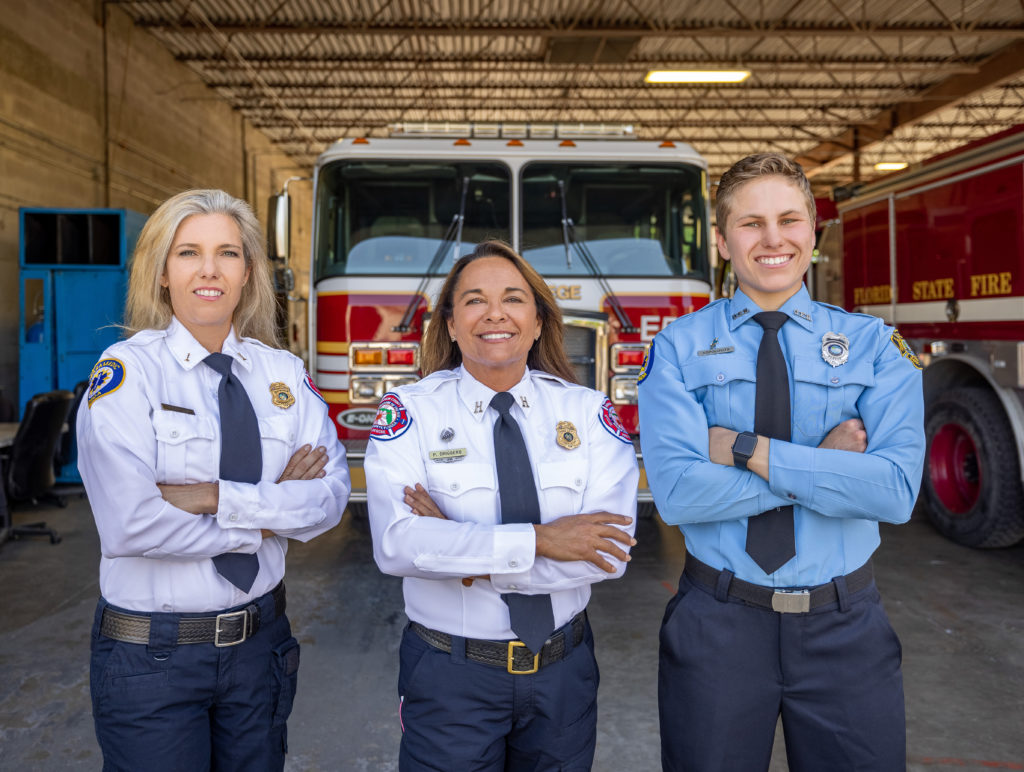
Only a small number of women have chosen a career as a firefighter in Marion County. The physicality and long hours make it a demanding profession for anyone. But, as three accomplished female firefighters explain, the sisterhood and brotherhood of the fire service offers a rewarding career for those willing to go above and beyond.
In a community where the fire rescue teams respond to medical emergencies far more often than fires, caring women with a desire to help their neighbors have a lot to offer.
Serving her Community
Lieutenant firefighter and paramedic Victoria Barreras is one of only six female firefighters employed by Marion County Fire Rescue (MCFR).
At just 18 years old, Victoria Barreras began volunteering at her community fire station, Marion County Station 1 in Anthony, which was run solely by volunteers in the early 1990s. Her boyfriend at the time was a volunteer firefighter. That relationship wouldn’t last but fighting fires would ignite a lingering passion.
“I fell in love with it through volunteering,” she explains. “I saw how much you gave back to the community and it was very local so I liked that aspect of it.”
Responding to fire calls in the Sparr/Anthony area where she lived, Barreras worked alongside husband and wife volunteer team Gene and Birdie McCarthy at a time when there were only a few female first responders in the entire county.
“Birdie was another female so I thought if Birdie could do it, I could do it,” she remembers.
Although fighting fires requires a lot of physical strength, Barreras never doubted she could do it if she was willing to put in the hard work.
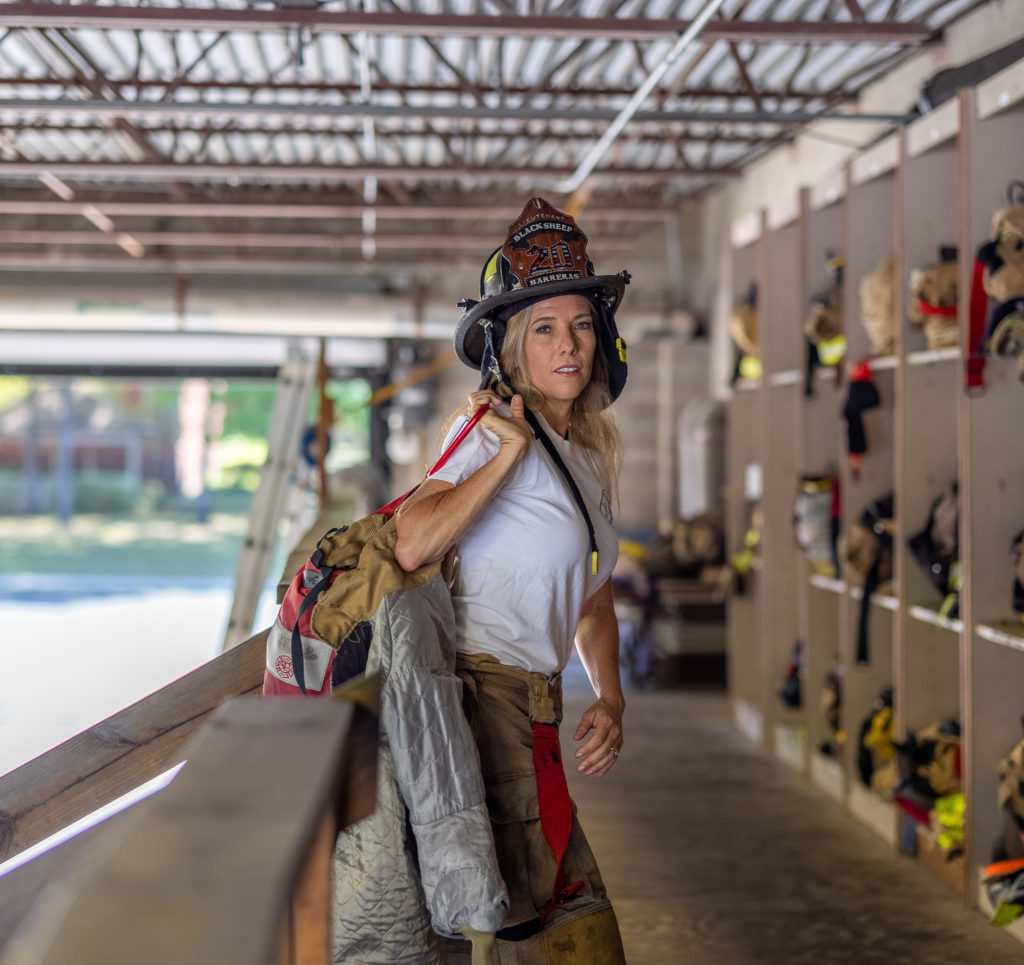 “My dad was military; he was a Marine and I was his girl,” she notes. “He was an outdoor guy and a really hard worker. My mom also always had really good work ethic.” It was simply a matter of “putting time and effort into accomplishing something,” she says. Her mother, Renate Barreras, who traveled the world as a flight purser (a cabin manager who oversees the flight attendants), remembers there was no deterring her daughter away from her chosen—if dangerous—career.
“My dad was military; he was a Marine and I was his girl,” she notes. “He was an outdoor guy and a really hard worker. My mom also always had really good work ethic.” It was simply a matter of “putting time and effort into accomplishing something,” she says. Her mother, Renate Barreras, who traveled the world as a flight purser (a cabin manager who oversees the flight attendants), remembers there was no deterring her daughter away from her chosen—if dangerous—career.
“I knew that was what she was going to do,” she recalls.
Before long, the volunteer firefighter enrolled at Central Florida Community College (now the College of Central Florida) for more training.
“If you had your EMT you could provide more care and help more,” she explains. So although she had originally planned to major in veterinary medicine at the University of Florida, Barreras switched gears and found she enjoyed providing emergency medical care to people even more than pets. She went on to complete three semesters of paramedic school and earn her paramedic license.
“In our hearts we love the calls where we really make a difference,” she says. “If you have someone who’s having a heart attack and you catch it, correct the issue and you give them more time with their family, those are the ones you really are eager for.”
Barreras began working as a paramedic for the ambulance service, which, at that time, was separate from the fire department. After a few years, she found out the county was hiring firefighter paramedics and decided to take on the challenge of fire college—where she was the only woman in the class.
“It was hard,” she admits, adding, “I never minded it.”
She had already experienced that level of physical exertion as a volunteer, she explains, but points out that succeeding in fire training as a petite person requires extra effort and a few specialized techniques.
“Being a little taller and wider would obviously help a lot,” she notes with a laugh.
Her strategy was simply to work twice as hard.
“Whatever we did in the morning I would usually do in the evening,” she recalls. “When we were done, I would go back out and pull the hose again, climb the stairs again.”
Barreras and her mother fondly remember her dad’s contribution to her fire training.
“My dad used to fall down in the living room,” Barreras remembers. “He’d be like, ‘OK honey, I’m your victim. You’ve got to get me up.’”
In the fire service, men and women are held to the same physical agility standards. Learning techniques that allowed Barreras to use her lower body strength to her advantage made all the difference.
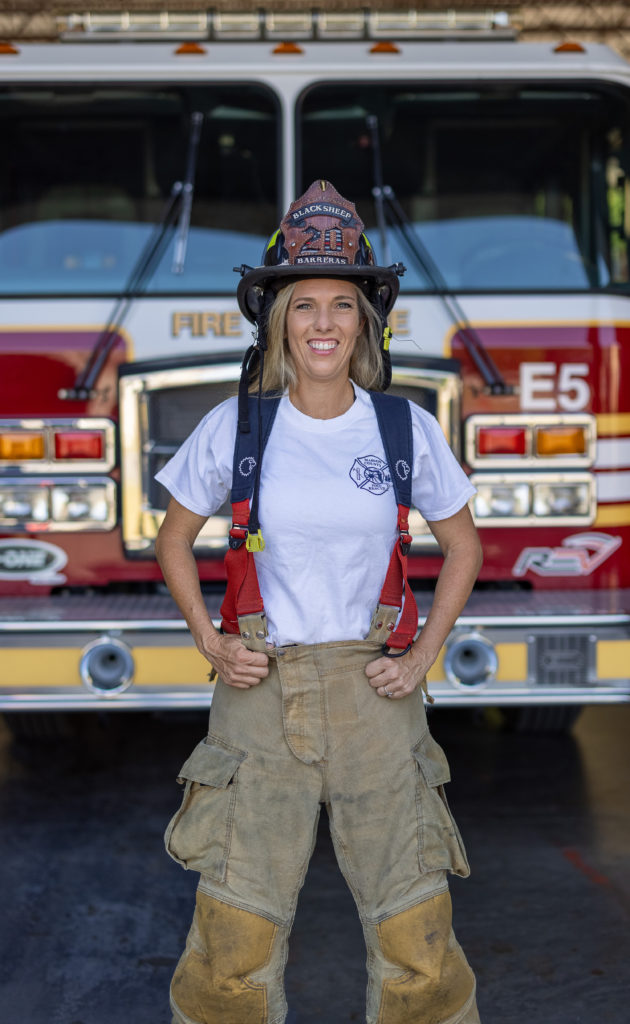 “The guys can pretty much lean over and pick up a ladder. I lean over and bump it up with my leg,” she explains. When picking up a patient on a medical call, instead of relying on brute strength, she employs maneuvers such as placing a sheet under their shoulders or using a gait belt. And for the last 15 years, as a part-time instructor for EMS students at the College of Central Florida (CF), she shares these techniques with future first responders.
“The guys can pretty much lean over and pick up a ladder. I lean over and bump it up with my leg,” she explains. When picking up a patient on a medical call, instead of relying on brute strength, she employs maneuvers such as placing a sheet under their shoulders or using a gait belt. And for the last 15 years, as a part-time instructor for EMS students at the College of Central Florida (CF), she shares these techniques with future first responders.
“I enjoy teaching, and their enthusiasm. If you can teach somebody a trick of the trade in the back of a rescue or how to pick up a ladder or just little things that can benefit them later, and that hopefully they’re going to pass on, that’s the nice part. I’ll have students call me years later and tell me about a call and be like, ‘We did this scenario in class and I remembered it.’”
Barreras offers the following advice to her students, “Trust your intuition. Be ethical; do what’s right. And stay learning—don’t stop educating yourself.”
As a lieutenant at Station 21 near On Top of the World, she acts as the shift leader for a lot of young firefighters she says are “impressionable about everything.” She directs them with advice she knows to be true from firsthand experience; five years ago, on her day off, Marion County fire crews extricated her own mother from her vehicle and took her to the hospital after a bad car accident.
“I always tell them to treat every call you go on as if it’s your home or it’s your family,” she notes. “That’s your grandmother or your mother. You never know who you’re taking care of.”
Barreras became a firefighter to help her community, but working 24-hour shifts requires some understanding from families, she notes. Her husband John Riolo is also a Marion County firefighter/paramedic and they’ve had to miss some birthdays and holidays at home.
Their 11-year-old son Wyatt recently told Barreras their life feels “normal” since she’s been a firefighter his whole life. Her 10-year-old daughter Scarlett, who’s been spotted giving her dolls CPR and bandaging their “broken arms,” told her mom she’s “cool” because she “saves lives.” They see her fulfilled in her career, and that means a lot to Barreras, who wants them to get an education and work hard but to ultimately do what makes them happy.
“I love being out in the community. I love teaching,” she says. “I like making a difference.”
Reaching New Heights
Firefighter/Paramedic Nicole “Kopo” Kopolovits is one of seven women employed as Ocala Fire Rescue (OFR) firefighters and is OFR’s only female to ever earn her smoke diver certification.
There was definitely a bit of hero worship when Nicole Kopolovits had her earliest encounters with first responders. As the child of a diabetic mother in South Florida, with a father who worked long hours, she and her older sister learned at a young age to call 911 if their mom needed help.
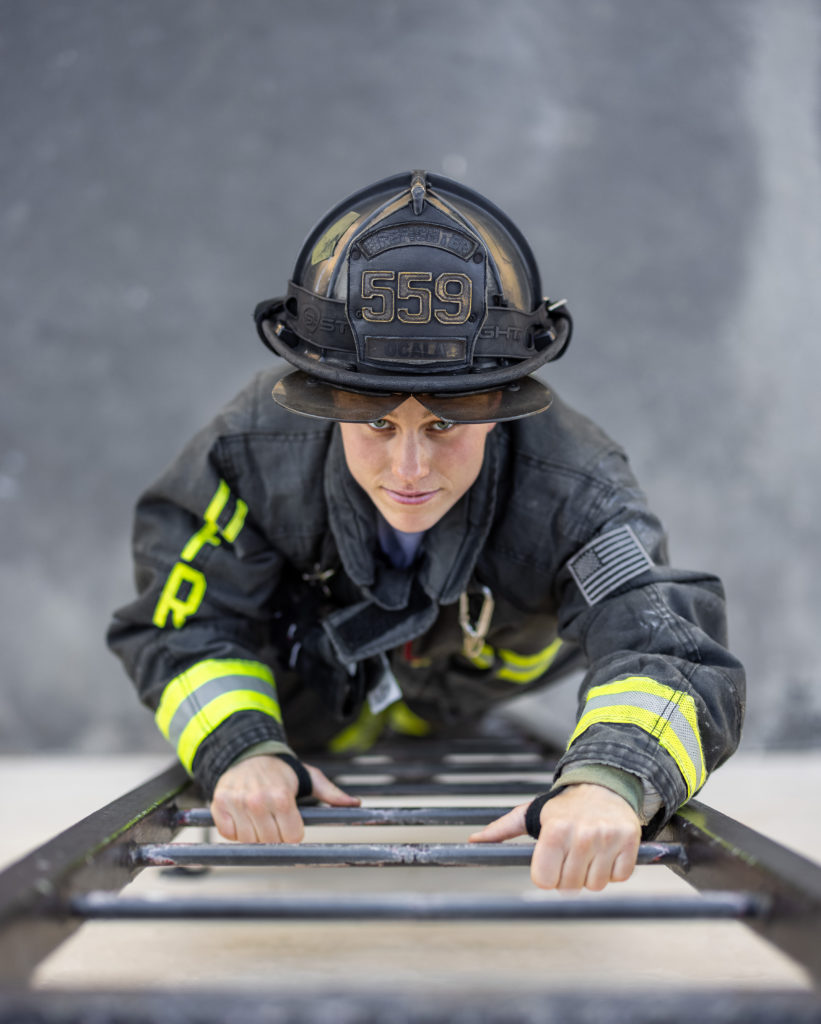 “The paramedic firefighters would come to the house and they would save her,” Kopolovits remembers. “I would be scared and crying; I was very young. And they would talk to us and make me feel better. I was like, This is super cool. These people are heroes.”
“The paramedic firefighters would come to the house and they would save her,” Kopolovits remembers. “I would be scared and crying; I was very young. And they would talk to us and make me feel better. I was like, This is super cool. These people are heroes.”
Always active and athletic, Kopolovits started taekwondo when she was 6 years old, and says that laid a foundation of “discipline, work ethic and being in shape.” In high school, she played percussion in the marching band and planned to go to college and major in music. However, when her plans changed and she enrolled at Broward Community College, she knew right away she wanted to take EMT classes—which she credits as the “greatest decision” she ever made. She earned her EMT certification and went right on to complete paramedic school. Then, realizing there are far more job opportunities for paramedics who also are firefighters, she came to Ocala to attend Florida State Fire College, as one of two females in her class, where “everything really just fell into place.”
“As soon as I went I loved it,” she remembers. “I liked doing all the activities we learned. I liked the challenge of it. I loved that everything was like a team—you communicated and you solved the issue together.”
When she graduated from fire school five years ago, Kopolovits accepted a job with OFR, where, she says, “Being a female in a male-dominated career doesn’t cross my mind, because we have such a respect for each other.”
Kopolovits laughs now about “showing up at fire school with long, blond hair.” She figured some of the guys were probably underestimating what “this little girl” could do until they had their first day of physical training and she “demolished those dudes.” Her strategy, she says, has always been to “keep her mouth shut and show what she can do.”
After her first year of probationary employment, she got a job in a catheterization laboratory on her days off from the fire station because she “can’t stand sitting still.” However, she decided she was working way too much after meeting her girlfriend, Jessica Mayes, and cut back on some hours so they could spend time together. Because Mayes is a paramedic for Marion County and they work the same shift, the two share an understanding of the demands of the job and they’re able to relax and recharge on their days off and spend quality time with their dog, Lexi.
Like Barreras, Kopolovits says learning techniques to accomplish some physically demanding tasks as a smaller person helped her to be successful, noting that some of her male teammates who have shorter or slimmer body types helped her with tips for different ways to hold a pike pole or ways to bend or use the strength in her legs to her advantage. Since joining CF’s EMS program as a part-time instructor nearly three years ago, she tries to pass along tips she’s learned. She also takes every opportunity to continue her own education.
Kopolovits is currently earning her bachelor’s degree online. She recently completed the fire department’s confined spaces training, which she says is a step towards qualifying to one day join the special operations team made up of firefighters with advanced knowledge in extrication tools and techniques—“anything that would require ropes and pullies…rappelling…or getting someone off a building or out of a ditch.”
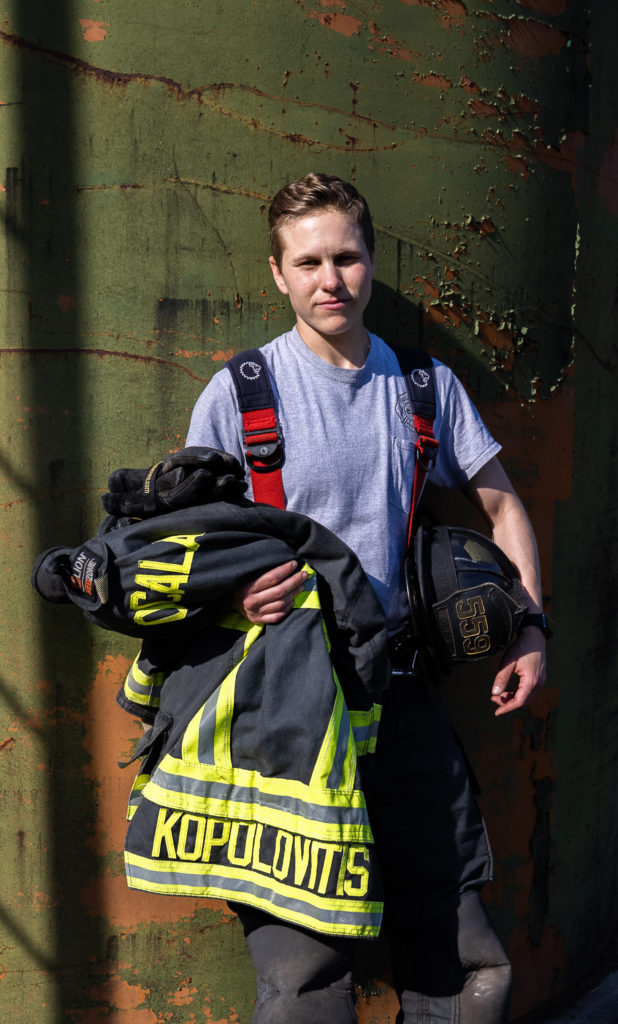 The 26-year-old never shies away from a new challenge, and recently accomplished something few women have even attempted.
The 26-year-old never shies away from a new challenge, and recently accomplished something few women have even attempted.
On January 9th, Kopolovits became Ocala Fire Rescue’s first-ever female certified Florida smoke diver. The elite designation is awarded after an intense 30-hour, six-day course designed to push experienced firefighters to their limits with smoky burn and search scenarios that require hours in hot bunker gear breathing with the aid of a heavy air pack as well as grueling physical workouts. For Kopolovits, who’s always looking for a new opportunity to challenge herself, it was the culmination of a year of training.
“I can’t even explain the feeling; I don’t know how I would get it again,” she says of completing the course.
As a paramedic, Kopolovits has additional medical training that allows her to provide more advanced care than the EMT certification required for all Ocala and Marion County firefighters. Unlike an EMT, who can perform CPR, provide oxygen and do basic life support and first aid, she is trained to start an IV, insert an oral airway, interpret an EKG and administer medications, for instance. When her crew responds to a call for assistance, she says they’re always there on “the worst day of somebody’s life.”
She’s saved a grandmother in cardiac arrest who “at some point was dead” and she’s delivered a baby in the middle of the night. The one thing every call has in common, Kopolovits notes, is that she “needs to be the best I can be.”
“When I’m at work, this is all I care about. This is where my head’s at. I’m here to do this job. I trained in my fire gear so I’m ready for a fire. I can save you and your family. If I go on a medical call, I know what I’m supposed to do.”
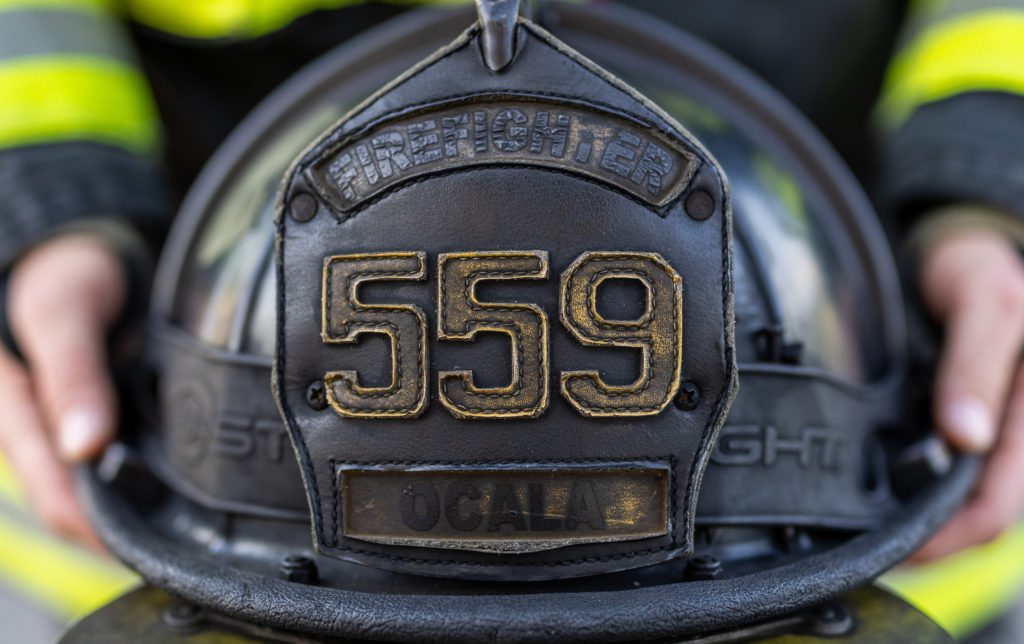 And yes, she’s helped many diabetic patients who, like her mom, sometimes experience unstable blood sugar levels. And when the patient is a parent, she makes a special connection with their children.
And yes, she’s helped many diabetic patients who, like her mom, sometimes experience unstable blood sugar levels. And when the patient is a parent, she makes a special connection with their children.
“It’s close to me,” she notes. “I always help the person in need, but if there’s kids on scene I always try and get them to the side before we leave and tell them, ‘Hey, you did a good job.’” Educating patients and their families is part of her job, she explains, so she might give them tips about glucose tablets or gel or make sure the children know what to do if it happens again.
“It’s the greatest job in the world,” Kopolovits enthuses. “I get to go the fire station, hang out with my best friends and, on top of that, you get to help people. Or you get to save somebody’s life. This is where I was meant to be.”
Leading by Example
Captain Pam Driggers is MCFR’s only female captain. She has worked her way up through the ranks over her nearly 27-year career.
She still laughs when she remembers rolling fire hoses in a business skirt. Pam Driggers had been asked to be the treasurer for the volunteer firefighters at MCFR Station 18 in Belleview. The young single mother worked as an office manager, so the bookkeeping was no problem. But she soon wanted to understand more about emergency response.
“I thought, if I’m going to be signing my name to these checks, I want to see what I’m actually signing,” she recalls.
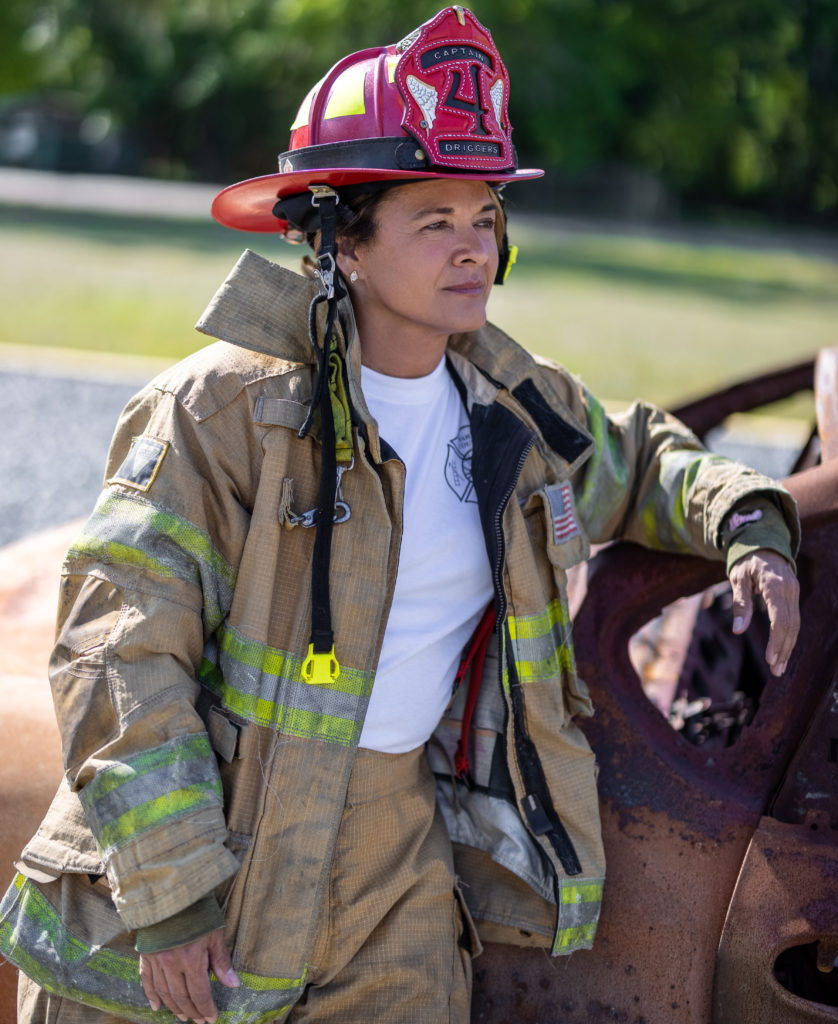 So, she signed up for a volunteer firefighter class. She remembers wearing tennis shoes inside her bunker boots to keep them on because back then gear didn’t come sized for a petite woman who stands just 5 feet tall in her shoes.
So, she signed up for a volunteer firefighter class. She remembers wearing tennis shoes inside her bunker boots to keep them on because back then gear didn’t come sized for a petite woman who stands just 5 feet tall in her shoes.
“I used to get off work and run to class, learning to fight fire,” she recalls. “I thought, I really like this.”
It was 1990 and there were very few women employed as firefighters anywhere, but it just so happened there were two at Station 18. Riding along with them on the back of the fire engine, Driggers thought, You know, I could do this.
“I think it’s the adrenaline and the excitement,” she explains. “For me the big thing is the community—being part of the community, getting out there and helping and making a difference in people’s lives.”
In 1993, Driggers completed fire standards training at the Florida State Fire College and then enrolled in EMT school at CF. Upon graduation in 1994 she was hired by Marion County.
At the time, her two sons, Daniel and Chris, were in elementary and middle school. They worried about her, she says, but they knew she was “tough.”
“They’re proud of me,” she notes. She had taught them to be self-sufficient and “knew they were strong kids.”
Back then, “it was well known that women didn’t belong in the fire service,” Driggers admits. But she wasn’t going to let anyone else’s doubts keep her from the career she wanted.
“It just made me mad, and more determined,” she says. It helped to have support from the other two women at Station 18.
“I knew if I had questions, I could call. They’d be like, ‘Come on, Pam, let’s work on this ladder.’”
Being the mom of two boys turned out to be an asset when the department wanted to start a Boy Scout Explorer post in the late 1990s. Driggers had helped start Boy Scout Troop 982 at Harbour View Elementary School.
“My son was part of them too, so that gave us that family activity,” she remembers. Although her children are now grown, she still enjoys working with young people in the Explorer program.
Participating in MCFR’s honor guard also means a lot to Driggers, who helped organize the honor guard team more than 20 years ago, after a volunteer firefighter died in the line of duty.
“It’s important for the families,” she explains. “It’s important to let them know that their son, daughter, wife, husband or child was making a difference in other people’s lives. That if they gave their life in the line of duty it meant something. And it helps to give them closure. It pays respect to our brothers and sisters.”
Driggers is the deputy commander for the Florida Fallen Firefighter Memorial and the co-lead instructor for the honor guard academy. She was an instructor at the fire college for several years and enjoys opportunities to talk with high school students in the Career Academy or present at career days. She tells young people that although the fire service is not like they see on TV, “real life fire” is “a very rewarding job.”
“You do have to be physically fit, and you have to be mentally tough,” she cautions. “You have to be strong enough to see and face what we face on a daily basis. But it’s an awesome brotherhood and sisterhood job.”
Since she was first promoted to shift leader in 2001, later to lieutenant and then to captain in 2003, Driggers has served as a team leader.
“I work hard, but my team makes me look good,” she says.
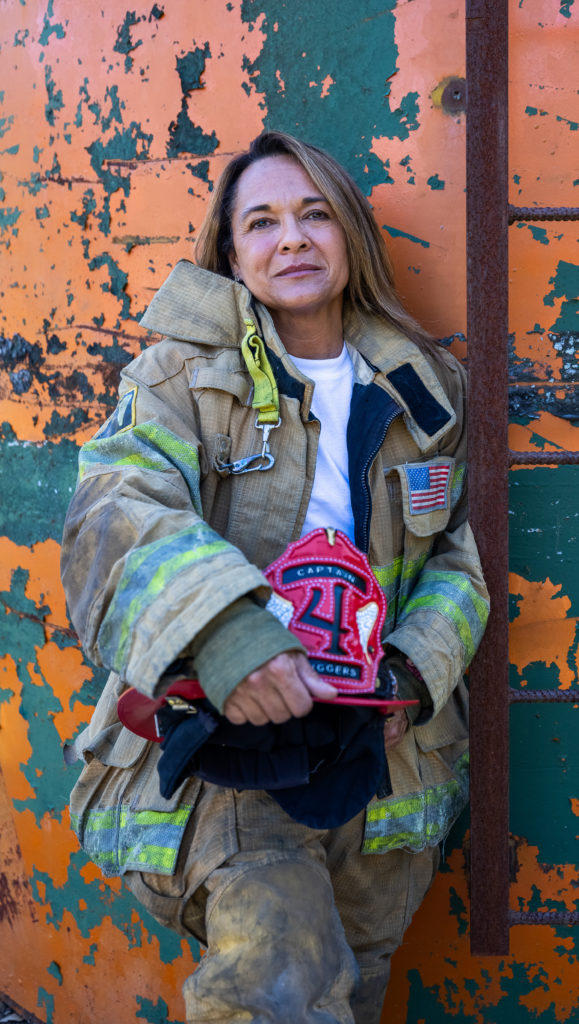 She sees one of her most important functions as an officer as setting the tone for her crew at MCFR Liberty Station 32.
She sees one of her most important functions as an officer as setting the tone for her crew at MCFR Liberty Station 32.
“I walk in every morning and call them all ‘Sunshine,’ she says with a laugh. “‘Good morning, Sunshine’ to the outgoing crew and to my crew coming in. ‘This is going to be a great day.’”
In her free time, Driggers enjoys spending time with her two granddaughters. She wants young women to understand that they have a lot to offer their community, even in a male-dominated profession.
“Females bring a lot to the fire service,” she says. “We may not be that big, burly person, but we bring to the table a whole different aspect and outlook than what the traditional gender-specific roles do. Ninety percent of our calls are medical calls.” And, often, that means a car wreck or a cardiac arrest, she explains, but just as often, it means “helping and holding that elderly person’s hand at 2 o’clock in the morning because their back hurts or their wrist hurts and they’re afraid because they’re by themselves; they’re lonely and they need somebody to talk to.”
“That’s what we provide—service to our community,” she declares. “You have to have that caring aspect about you and want to make a difference in people’s lives and to take care of your community. We’re going to get dirty and tired, but we’re going to take care of each other doing it.”
For information on becoming a firefighter, visit ocalafire.org/mentor or the Florida State Fire College website at myfloridacfo.com/division/SFM/bfst






